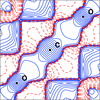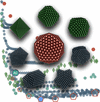issue contents
January 2020 issue

Cover illustration: X-ray diffraction and Compton scattering are equally essential to quantum crystallography because they provide complementary information on the one-electron reduced density matrix (1-RDM) in a crystal. The reconstruction of a 1-RDM solely from X-ray structure factors is bound to yield an inaccurate picture of its off-diagonal regions (as can be seen in the cover image). In this issue, De Bruyne and Gillet [Acta Cryst. (2020), A76, 1-6] describe a method to infer the 1-RDM for a molecular crystal from both experimental data sets while enforcing the necessary N-representability conditions.
advances
research papers
foundations
research papers
 access
access

 access
access access
access access
access

 journal menu
journal menu





























